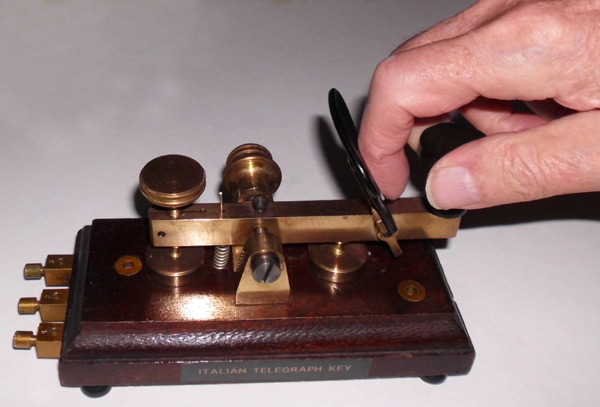Informationen zu Swiss/Italian Style
Land Line Key
ca 1900
Info von W1TP
1295 * EARLY STYLE SWISS / ITALIAN LAND LINE KEY:(25KB)
This medium sized brass key has the unique automatic shorting contacts that are typical of the early Swiss/Italian land line keys.
Placing fingers on the knob pushes a plastic plate forward and unshorts the key readying it for transmission.
Releasing the lever automatically places it in the receive mode.
Greg Ulsamer reports that this key is called the ''Forchieri-key'' which is a family name from the Italian portion of Switzerland.
It was first made by the workshops of the Swiss Telegraph Administration in the 1890s and used on
the American type of Closed Circuit lines in Switzerland.
In den 1890er-Jahren richtete die Schweizer Telegrafenverwaltung wieder eine eigene Reparaturwerkstatt ein.
Diese fertigte unter anderem Tasten mit einem Kurzschlussbügel, sog. Forcieri-Tasten.
Der Italiener Pietro Forcieri hatte 1883 ein Buch über elektrotechnische Telegrafen veröffentlicht und später
diese Taste für amerikanischen Ruhestrom entwickelt.
Das Italienische Ministerium für Post und Telegrafie führte diese Betriebsart 1899 ein.


The has the spring loaded shorting switch on the key lever so itis always shorted for the telegraph line.
Only opening up the connection when the operator uses the knob in front of it.
There are three terminals at the rear for wire connections to equipment. There are both front and rear contacts.
The wood base is 5 7/8 inches long and 2 1/2 inches wide.
The overall length of the key from the very rear of the back terminals to the front edge of the knob is about 6 1/4 inches.
The overall height is about 4 1/4 inches to top of the switch handle.
The key alone weights about 1 pound and 1 ounce.
Taste für amerikanischen Ruhestrom.
Solange nicht gearbeitet wurde, war der Stromkreis geschlossen; er führte über eine Aufrufklappe. (Abb.)
Beim Senden wurde diese über den Tastenhebel mit dem Finger nach vorn geschoben und damit der Ruhestrom
unterbrochen, so dass die Zeichen, wie beim Arbeitsstrom, durch Schließen des Stroms hervorgerufen wurden.












